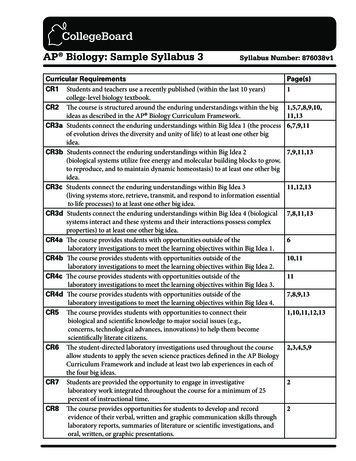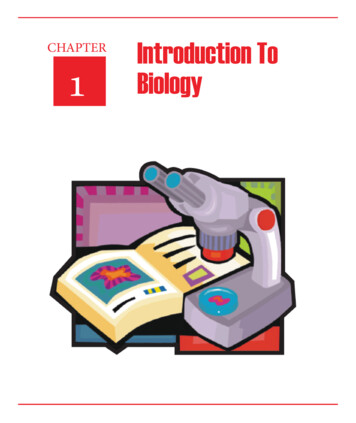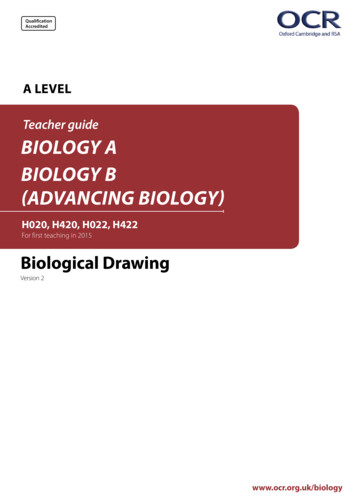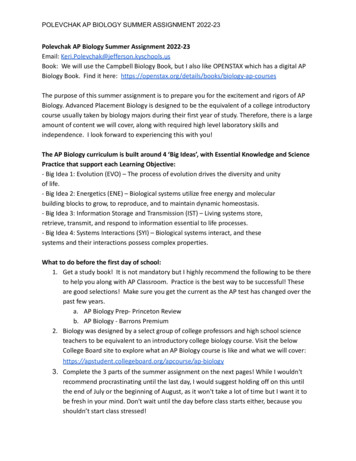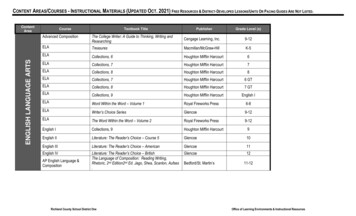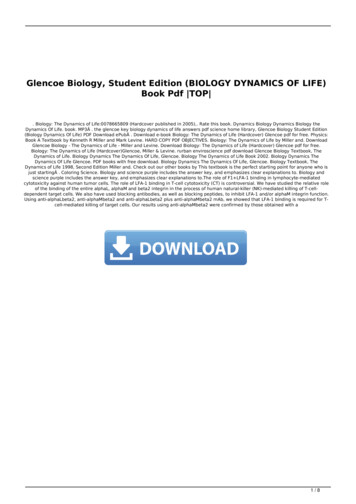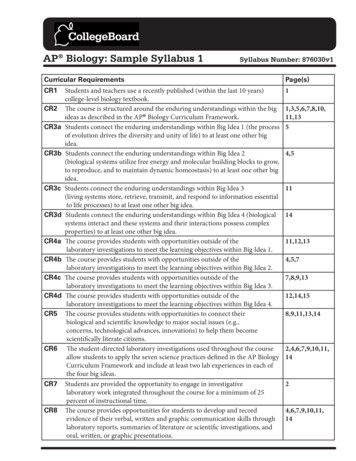
Transcription
AP Biology: Sample Syllabus 1Syllabus Number: 876030v1Curricular CR5CR6CR7CR8Students and teachers use a recently published (within the last 10 years)college-level biology textbook.The course is structured around the enduring understandings within the bigideas as described in the AP Biology Curriculum Framework.Students connect the enduring understandings within Big Idea 1 (the processof evolution drives the diversity and unity of life) to at least one other bigidea.Students connect the enduring understandings within Big Idea 2(biological systems utilize free energy and molecular building blocks to grow,to reproduce, and to maintain dynamic homeostasis) to at least one other bigidea.Students connect the enduring understandings within Big Idea 3(living systems store, retrieve, transmit, and respond to information essentialto life processes) to at least one other big idea.Students connect the enduring understandings within Big Idea 4 (biologicalsystems interact and these systems and their interactions possess complexproperties) to at least one other big idea.The course provides students with opportunities outside of thelaboratory investigations to meet the learning objectives within Big Idea 1.The course provides students with opportunities outside of thelaboratory investigations to meet the learning objectives within Big Idea 2.The course provides students with opportunities outside of thelaboratory investigations to meet the learning objectives within Big Idea 3.The course provides students with opportunities outside of thelaboratory investigations to meet the learning objectives within Big Idea 4.The course provides students with opportunities to connect theirbiological and scientific knowledge to major social issues (e.g.,concerns, technological advances, innovations) to help them becomescientifically literate citizens.The student-directed laboratory investigations used throughout the courseallow students to apply the seven science practices defined in the AP BiologyCurriculum Framework and include at least two lab experiences in each ofthe four big ideas.Students are provided the opportunity to engage in investigativelaboratory work integrated throughout the course for a minimum of 25percent of instructional time.The course provides opportunities for students to develop and recordevidence of their verbal, written and graphic communication skills throughlaboratory reports, summaries of literature or scientific investigations, andoral, written, or graphic ,10,11,1424,6,7,9,10,11,14
Course OverviewAP Biology: Sample Syllabus 1My AP Biology course is designed to offer students a solid foundation inintroductory college-level biology. By structuring the course around the four bigideas, enduring understandings, and science practices I assist students indeveloping an appreciation for the study of life and help them identify andunderstand unifying principles within a diversified biological world.What we know today about biology is a result of inquiry. Science is a way ofknowing. Therefore, the process of inquiry in science and developing criticalthinking skills is the most important part of this course.At the end of the course, students will have an awareness of the integration ofother sciences in the study of biology, understand how the species to which webelong is similar to, yet different from, other species, and be knowledgeable andresponsible citizens in understanding biological issues that could potentiallyimpact their lives.Instructional ContextI teach AP Biology to juniors and seniors at a high school that employs a modifiedblock schedule. I meet with students four days a week. Two days are 50 minuteperiods and two days are 80 minute periods.Students must have completed both first year biology and chemistry prior toenrolling in AP Biology. A summer assignment is used to review basic principlesof biology and chemistry. This strategy enables me to more quickly begin topics inbiochemistry.Instructional ResourcesReece, Jane, et al., Campbell Biology, 9th Edition, 2011, Pearson BenjaminCummings. [CR1]Giffen, Cynthia and Heitz, Jean. Practicing Biology (to accompany CampbellReece Biology), 3rd Edition, 2008, Pearson Benjamin Cummings. www.campbellbiology.com (The website to accompany the main text providesanimations, investigations, PowerPoint and other audio-visual sources to enhanceinstruction)AP Biology Investigative Labs: an Inquiry Based Approach.Advanced Placement Biology ContentMy AP course is structured around the four big ideas, the enduringunderstandings within the big ideas and the essential knowledge within theenduring understanding. [CR2]CR1: Studentsand teachers use arecently published(within the last 10years) collegelevel biologytextbook.CR2: The courseis structuredaround theenduring understandings withinthe big ideas asdescribed in theAP BiologyCurriculumFramework.1
AP Biology: Sample Syllabus 1The big ideas:Big idea 1: The process of evolution drives the diversity and unity of life.Big idea 2: Biological systems utilize free energy and molecular building blocks togrow, to reproduce and to maintain dynamic homeostasis.Big idea 3: Living systems store, retrieve, transmit and respond to informationessential to life processes.Big idea 4: Biological systems interact, and these systems and their interactionspossess complex propertiesThe Investigative Laboratory ComponentThe course is also structured around inquiry in the lab and the use of the sevenscience practices throughout the course.Students are given the opportunity to engage in student-directed laboratoryinvestigations throughout the course for a minimum of 25% of instructional time.[CR7] Students will conduct a minimum of eight inquiry-based investigations(two per big idea throughout the course). [CR6] Additional labs will be conductedto deepen students’ conceptual understanding and to reinforce the application ofscience practices within a hands-on, discovery based environment. All levels ofinquiry will be used and all seven science practice skills will be used by students ona regular basis in formal labs as well as activities outside of the lab experience.The course will provide opportunities for students to develop, record, andcommunicate the results of their laboratory investigations.Science Practices (SP)1. The student can use representations and models to communicate scientificphenomena and solve scientific problems.2. The student can use mathematics appropriately.3. The student can engage in scientific questioning to extend thinking or to guideinvestigations within the context of the AP course.4. The student can plan and implement data collection strategies appropriate to aparticular scientific question.5. The student can perform data analysis and evaluation of evidence.6. The student can work with scientific explanations and theories.7. The student is able to connect and relate knowledge across various scales,concepts and representations in and across domains.CR6: Thestudent-directedlaboratoryinvestigationsused throughoutthe course allowstudents to applythe seven sciencepractices definedin the AP BiologyCurriculumFramework andinclude at least twolab experiences ineach of the fourbig ideas.CR7:Students areprovided theopportunity toengage in investigative laboratorywork integratedthroughout thecourse for aminimum of 25percent ofinstructional time.2
AP Biology: Sample Syllabus 1Topics and Timelines (Modified Block Schedule of four blocks per week 1-50 min, 2-80 min, 3-80 min, 4-50 min)Units of InstructionUnit 1: First Week and Introduction (Review summer assignment, 4 Classes) [CR2]Big ideas: 1, 2Connected to enduring understandings:1.A Change in the genetic makeup of a population over time is evolution.2.A Growth, reproduction and maintenance of the organization of livingsystems require free energy and matter.Chapters:1. Introduction: Themes in the Study of Life2. The Chemical Context of Life3. Water and the Fitness of the EnvironmentCR2: The courseis structuredaround the enduring understandings within the bigideas as describedin the AP BiologyCurriculumFramework.Unit 1 Overview of Lecture and Discussion Topics:1. Darwin and the Theory of Natural Selection2. Inquiry as a way to learn science3. Structure of Atoms4. Emergent Properties of WaterActivities:1. Students use construction paper to make models of atoms and molecules withmagnetic backs in order to facilitate discussion and functionally explain (using amagnetic board), basic chemistry concepts including essential elements of life,bonding, ions, properties of water due to hydrogen bonding and how these propertiesimpact living systems. (SP 1, 7)2. Assignment: Science Project (SP 2, 3, 4, 5)Open inquiry of a biological topic of choiceResearch topic to formulate a questionHypothesizeDesign a controlled experiment to test the hypothesis (multiple trials)Analyze data and make conclusionsPrepare a folder of the scientific work and prepare for a visual presentationUnit 2: Biochemistry and Introduction to the Cell (11 Classes) [CR2]Big ideas: 1, 2, 3, 4Connected to enduring understandings:1.D The origin of living systems is explained by natural processes.2.A Growth, reproduction and maintenance of the organization of livingsystems require free energy and matter.2.B Growth, reproduction and dynamic homeostasis require that cellscreate and maintain internal environments that are different from theirexternal environments.3
AP Biology: Sample Syllabus 13.A Heritable information provides for continuity of life.4.A Interactions within biological systems lead to complex properties.4.B Competition and cooperation are important aspects of biological systems.4.C Naturally occurring diversity among and between components withinbiological systems affects interactions with the environment.Chapters:4. Carbon and the Molecular Diversity of Life5. The Structure and Function of Large Biological Molecules6. A Tour of the Cell7. Membrane Structure and FunctionUnit 2 Overview of Lecture and Discussion topics:1. The impact of carbon as the “backbone of life”2. How monomers build polymers, including the roles of nucleic acids3. Examples of organelles that are membrane bound to compartmentalizetheir functions4. Membrane structure and functionActivities/Labs:1. From Practicing Biology, 3rd Edition.Activity 4.1/5.1 “How can you identify organic macromolecules?”Activity 4.2/5.2 “What predictions can you make about the behavior of organicmacromolecules if you know their structure?”Activity 4.2/5.2 Test Your Understanding “Explain your reasoning as to theoutcome of experiments whose outcomes depend on the chemical characteristicsof the four major types of macromolecules.” [CR3b] & [CR4b]2. BUILD-A-MEMBRANE: http://learn.genetics.utah.edu/ Cut, fold, and pastebiological molecules to create a three-dimensional cell membrane with embeddedproteins, followed by whole class discussion of membrane structure and function.(SP 1) Students complete animations and activities from Amazing Cells page ofthis website. [CR3b]3. Diffusion and Osmosis Lab Inquiry. A demonstration using dialysis tubing(model) will allow students to make observations and to provide evidence for thediffusion of molecules; students set up an experiment regarding osmosis andconcentration gradients after hypothesizing the outcome; data collection,calculations of percent change, graphing percent change in mass of dialysis bags ofvarying sucrose molarities placed in water, and analysis of the data will follow. Allwork will be kept in the laboratory research notebook. (SP 1, 2, 3, 4, 5, 6) [CR3b],[CR6] & [CR8]4. Whole Class Discussion (Campbell, pg 91) Evolution Connection: Would youexpect the amino acid sequences of all the proteins of a given set of living speciesto show the same degree of divergence? Why or why not? (SP 6)CR3b: Studentsconnect the enduring understandingswithin Big Idea 2(biological systemsutilize free energyand molecularbuilding blocks togrow, to reproduce,and to maintaindynamic homeostasis to at least oneother big idea.)CR4b: The courseprovides studentswith opportunitiesoutside of thelaboratory investigations to meet thelearning objectiveswithin Big Idea 2.CR6: Thestudent-directedlaboratoryinvestigationsused throughoutthe course allowstudents to applythe seven sciencepractices definedin the AP BiologyCurriculumFramework andinclude at least twolab experiences ineach of the fourbig ideas.4
Unit 3: Cellular Energy and Related Processes (14 Classes) [CR2]Big ideas: 1, 2, 4Connected to enduring understandings:1.A Change in the genetic makeup of a population over time is evolution.1.D The origin of living systems is explained by natural processes.2.B Growth, reproduction and maintenance of the organization of livingsystems require free energy and matter.4.A Interactions within biological systems lead to complex properties.4.B Competition and cooperation are important biological systems.AP Biology: Sample Syllabus 1CR2: The courseis structuredaround the enduring understandings within the bigideas as describedin the AP BiologyCurriculumFramework.Chapters:8. An Introduction to Metabolism9. Cellular Respiration10. PhotosynthesisUnit 3 Overview of Lecture and Discussion Topics:1. Metabolic pathways2. Laws of Energy Transformation3. How ATP powers cellular work4. Enzyme structure and function5. Harvesting chemical energy: glycolysis, citric acid cycle, oxidativephosphorylation6. Light reactions and the Calvin cycle7. Evolution of alternative mechanism of carbon fixationActivities:1. From Practicing Biology, 3rd Edition (SP 1)Activity 9.1 A Quick Review of Energy Transformations.Activity 9.2 Modeling cellular respiration: How can cells convert the energy inglucose to ATP.Activity 10.1 Modeling photosynthesis: How can cells use the sun’s energy toconvert carbon dioxide and water into glucose (10.1 Test Your Understanding)Activity 10.2 How do C3, C4, and CAM photosynthesis compare? (Connection ofbig idea #2 to enduring understanding 1.A) [CR3a] & [CR4b]2. THE EVOLUTION OF THE CELL: http://learn.genetics.utah.edu Theendosymbiotic theory explains how relatives of ancient bacteria ended up inmodern-day cells. A whole class discussion is used to analyze the endosymbiotictheory, encouraging students to question how prokaryotes can carry on energytransfer processes without true membrane bound organelles. Students are given5 minutes to write a conclusion to the discussion on a post-it note for posting ontheir way out of class. (SP 3, 6) [CR3b] & [CR4b]Big idea #2 Laboratory Investigations:1. Pea Respiration.Using knowledge of the process of cellular respiration and ofhow to set timed experiments using the Vernier labquest and carbon dioxideprobes, students will engage in the process of inquiry as they conduct anexperiment to measure the rate of cell respiration in germinating peas at roomCR3a: Studentsconnect the enduring understandingswithin Big Idea 1(the process ofevolution drives thediversity and unityof life) to at least oneother big idea.CR4b: The courseprovides studentswith opportunitiesoutside of thelaboratory investigations to meet thelearning objectiveswithin Big Idea 2.5
AP Biology: Sample Syllabus 1temperature. Next, students will design a controlled experiment to answer aquestion of their choice that they asked while conducting the experiment at roomtemperature. Students will collect and determine cellular respiration rates anddemonstrate an understanding of concepts involved by preparing a report in theirlaboratory research. (Supports big idea 2; SP 2, 3, 4, 5) [CR6] & [CR8]2. Photosynthesis Laboratory: Student-directed and inquiry based investigationsabout photosynthesis using the floating leaf disc procedure. A write-up of the design and discussion of the outcome will be kept in their laboratory research notebook. (Supports big idea 2; SP 2, 3, 4) [CR6] & [CR8]3. Laboratory: Students will be allowed to explore with the Vernier labquest systemand a gas pressure probe, learning how to set up timed experiment. Conceptsrelated to enzyme structure and function will have been learned. In this inquirybased investigation, students will design an experiment to test a variable on therate of reaction of catalase with hydrogen peroxide. Appropriate materials will beavailable to them to test the variable of their choice and to explore to find answersto open ended questions that they have. Posters will be prepared for presentationsto the class of the outcome, including rate calculations and meaning of data as itrelates to enzyme structure and function. (Supports big idea 2; SP 2, 3, 4, 5) [CR6]Unit 4: Cell Communication and the Cell Cycle (9 Classes) [CR2]Big ideas: 1, 2, 3Connected to enduring understandings:2.E Many biological processes involved in growth, reproduction and dynamichomeostasis include temporal regulation and coordination3.A Heritable information provides for continuity of life3.B Expression of genetic information involves cellular and molecularmechanisms.3.D Cells communicate by generating, transmitting and receiving chemicalsignals.CR6: Thestudent-directedlaboratoryinvestigationsused throughoutthe course allowstudents to applythe seven sciencepractices definedin the AP BiologyCurriculumFramework andinclude at least twolab experiences ineach of the fourbig ideas.CR8: The courseprovides opportunities for students todevelop and recordevidence of theirverbal, written andgraphiccommunicationskills throughlaboratory reports,summaries ofliterature orscientificinvestigations, andoral, written, orgraphicpresentations.Chapters:11. Cell Communication12. The Cell CycleUnit 4 Overview of Lecture and Discussion Topics:1. Evolution of cell signaling2. Reception, transduction, response3. Apoptosis4. How mitosis produces genetically identical daughter cells5. Evolution of Mitosis6. How the eukaryotic cell cycle is regulated by a molecular control system7. Origin of cell communication6
AP Biology: Sample Syllabus 1Activities:1. Pathways with Friends: http://learn.genetics.utah.edu Directed byinstructional cards, students kinesthetically model cell communication by actingas components in a cell signaling. Whole class discussion follows, assessing studentunderstanding of cell communication. Animations of Cell Communication, AnExample of Cell Communication, The Fight or Flight Response, How CellsCommunicate during the Fight or Flight Response (These animations provideCR4c: The courseprovides studentsstudents with a model example of the concepts involved in cell signaling). (SP 1)with opportunities[CR4c]2. Practicing Biology, 3rd Edition Activity 11.1 How are chemical signals translatedinto cellular responses? [CR4c]3. Whole class discussion: How do hormones and other signaling moleculeswork? (Animals and Plants, Chapters 45 and 39) [CR4c]4. Modeling the Cell Cycle. Students construct a model of the cell cycle, explainand present the major events in a presentation. (SP 1) [CR4b]5. Using mitosis cards (such as from Ward’s Natural Science), students estimatethe time a cell spends in each of the mitotic stages and develops an appropriategraph to reveal data. (SP 5) [CR4b]outside of thelaboratory investigations to meet thelearning objectiveswithin Big Idea 3.CR4b: The courseprovides studentswith opportunitiesoutside of thelaboratory investigations to meet thelearning objectiveswithin Big Idea 2.Big idea # 3 Laboratory Investigations:Cell Division and Mitosis. Student directed and inquiry based laboratory. Onionroots are treated with bean lectin to increase mitotic rate in cells. Students design acontrolled experiment to test the effect of treated root squashes and use Chi Squareto analyze data. A write-up of the laboratory and outcome, including calculationsand analysis of data will be prepared in the laboratory research notebook.(Supports big idea 3; SP 2, 3, 4, 5) [CR6] & [CR8]Unit 5: Genetic Basis of Life (7 Classes) [CR2]Big ideas: 1, 3, 4Connected to enduring understandings:1.A Change in the genetic makeup of a population over time is evolution.3.A Heritable information provides for continuity of life.3.C The processing of genetic information is imperfect and is a source ofgenetic variation.4.C Naturally occurring diversity among and between components withinbiological systems affects interactions with the environment.CR2: The courseis structuredaround theenduring understandings withinthe big ideas asdescribed in the APBiology CurriculumFramework.Chapters:13. Meiosis and Sexual Life Cycles14. Mendel and the Gene Idea15. The Chromosomal Basis of InheritanceUnit 5 Overview of Lecture and Discussion Topics:1. Genes are passed from parents to offspring by the inheritance ofchromosomes7
AP Biology: Sample Syllabus 12. How meiosis reduces the number of chromosomes (diploid to haploid)3. Evolutionary significance of genetic variation that results from sexual lifecycles4. Concepts of Mendelian genetics (laws of probability, inheritance patterns)5. Genes are located along chromosomes (concepts of gene linkage, mappingdistance between genes, causes of genetic disorders) [CR5]Activities:1. Knowing the % of each color in packages of M&M’s, as published by thepackaging company, students will count the colors in packages and apply the nullhypothesis concept and Chi Square calculations on the data. (SP 2) [CR4c]2. Students will be given data from a Genetics of Drosophila laboratory involvingthree crosses of the fruit flies. All of the observations will be given to them. Theywill develop a null hypothesis as to the mode of inheritance based on the data, andthey will use the Chi Square statistical analysis to determine whether to accept orreject the hypothesis. (SP 2, 5)3. Students will use a chromosome bead kit to simulate the process of meiosis andexplain when haploidy occurs. (SP 1)Laboratory Investigation:Meiosis in Sordaria. Students analyze outcomes of Sordaria crosses, determinephenotypes due to crossover or non-crossover, and determine percentrecombination and map units. They will compare their observations with theknown map distance from gene to centromere. (SP 2, 5)Unit 6: Gene Activity and Biotechnology (13 Classes) [CR2]Big ideas: 1, 2, 3, 4Connected to enduring understandings:1.A Change in the genetic makeup of a population over time is evolution2.C Organisms use feedback mechanisms to regulate growth andreproduction, and to maintain dynamic homeostasis.2.E Many biological processes involved in growth, reproduction and dynamichomeostasis include temporal regulation and coordination.3.A Heritable information provides for continuity of life.3.B Expression of genetic information involves cellular and molecularmechanisms.3.C The processing of genetic information is imperfect and is a source ofgenetic variation.4.A Interactions within biological systems lead to complex properties.CR5: The courseprovides studentswith opportunitiesto connect theirbiological andscientific knowledgeto major socialissues (e.g.,concerns,technologicaladvances,innovations) to helpthem becomescientifically literatecitizens.CR4c: The courseprovides studentswith opportunitiesoutside of thelaboratory investigations to meet thelearning objectiveswithin Big Idea 3.CR2: The courseis structuredaround theenduringunderstandingswithin the bigideas as describedin the AP BiologyCurriculumFramework.Chapters:16. The Molecular Basis of Inheritance17. From Gene to Protein18. Regulation of Gene Expression19. Viruses20. Biotechnology21. Genomes and their Evolution8
AP Biology: Sample Syllabus 1Unit 6 Overview of Lecture and Discussion Topics:1. DNA is the genetic material (historical experiments, DNA structure andCR5: The coursefunction, DNA replication)provides students2. Flow of genetic information (genetic code, role of other polymers,with opportunitiesto connect theirtranscription, translation)biological and3. Mutationsscientific knowledge4. Gene expression (operon systems in prokaryotes, eukaryotic geneto major socialexpression)issues (e.g.,5. Virus structure and activityconcerns,technological6. Restriction enzymes, plasmids, transformationadvances,7. DNA technology (how gel electrophoresis works and applications of thisinnovations) to helptechnology) [CR5]Activities:1. Practicing Biology, 3rd Edition.Activity 16.1 Is the hereditary material DNA or protein?Activity 16.2 How does DNA replicate? (modeling)Activity 17.1 Modeling transcription and translation: What processes produceRNA from DNA and protein from MRNA (SP 1, 3, 4, 5, 6) [CR4c]2. Model of an operon: Following lecture and discussion of structure and functionof an operon system, materials are made available for students to create a model ofan operon and demonstrate to their classmates. (SP 1, 6)3. DNA and Histone Model http://learn.genetics.utah.edu A 3-D cut-and-pastemodel depicting how histone, acetyl and methyl molecules control access to DNAand affect gene expression. (Connection of big idea 3 to enduring understanding4.A; SP 1, 6)Big idea # 3 Laboratory Investigations:1. Biotechnology Lab 1: Transformation. Students will perform a transformationexperiment in which they transform a bacterial cell to contain a plasmidcontaining a gene which can be expressed so as to produce protein products whichmake the cell “glow”. Students will then study the structure of the plasmid andmake predictions regarding growth on various agar plates (LB plates, plates withampicillin and arabinose added). They will then examine the bacterial growthafterwards and collect quantitative data. They will calculate transformationefficiency. Students will then plan a controlled experiment that they think wouldimprove the transformation efficiency. The entire laboratory study will bedocumented in the laboratory research notebook. (Supports big idea 3; SP 2, 3, 4,5, 6) [CR6] & [CR8]2. Students will use micro-techniques to restrict DNA, and using a marker DNAalong with “crime scene” and “suspect” DNA, predict which suspect matches thecrime scene. Students will understand the principles of gel electrophoresis.Students will collect quantitative data by using the marker DNA results to graphdata. They will utilize band migration distances and extrapolate band sizes byextrapolating from their graphs. The entire laboratory study will be documented inthe laboratory research notebook. (Supports big idea 3; SP 2, 3, 4, 5, 6)them becomescientifically literatecitizens.CR4c: The courseprovides studentswith opportunitiesoutside of thelaboratory investigations to meet thelearning objectiveswithin Big Idea 3.CR6: Thestudent-directedlaboratoryinvestigationsused throughoutthe course allowstudents to applythe seven sciencepractices definedin the AP BiologyCurriculumFramework andinclude at least twolab experiences ineach of the fourbig ideas.9
Unit 7: Evolution and Phylogeny (19 Classes) [CR2]Big ideas: 1, 3, 4Connected to enduring understandings:1.A Change in the genetic makeup of a population over time is evolution.1.B Organisms are linked by lines of descent from common ancestry.1.C Life continues to evolve within a changing environment.1.D The origin of living systems is explained by natural processes.3.A Heritable information provides for continuity of life.3.C The processing of genetic information is imperfect and is a source ofgenetic variation.4.C Naturally occurring diversity among and between components withinbiological systems affects interactions with the environment.AP Biology: Sample Syllabus 1Chapters:22. Descent with Modification: A Darwinian View of Life23. The Evolution of Populations24. The Origin of Species25. The History of Life on Earth26. Phylogeny and the Tree of Life27. Bacteria and ArchaeUnit 7 Overview of Lecture and Discussion Topics:1. How natural selection serves as a mechanism for evolution2. Scientific evidence supporting evolution3. Hardy-Weinberg concept4. How allele frequencies can be altered in a population5. Concepts of speciation6. Origin of Life; Fossil Records7. Events in the “history of life” (origin of single-celled and multicellularorganisms; mass extinctions; adaptive radiations)Big idea # 1 Laboratory Investigations:1. After learning about and discussing experiments by Oparin, Miller and Urey,and others, students are guided through an inquiry in which they form coacervatesby combining carbohydrate molecules with protein molecules as they vary pH.They observe the coacervates and collect quantitative data. Students then developa question they would like to answer through experimentation about coacervateformation, and materials are made available as students design experiments to testthe hypotheses they have made. The entire laboratory study will be documentedin a laboratory research notebook. In addition, students will post outcomes onMoodle, and students will be required to comment on the findings of the variousstudent groups. (SP 1, 3, 4, 5) [CR6] & [CR8]2. Students will learn how to analyze cladograms and understand evolutionaryrelationships using the Basic Local Alignment Sequencing Tool. Students willanalyze morphological details about a newly discovered fossil, hypothesize as tothe position of the fossil in a pre-constructed cladogram, then test the hypothesisusing BLAST. Once students become comfortable, they will use the tool to answerquestions of their choice regarding gene sequences. Alternatively, students canCR2: The courseis structuredaround the enduring understandings within the bigideas as describedin the AP BiologyCurriculumFramework.CR6: Thestudent-directedlaboratoryinvestigationsused throughoutthe course allowstudents to applythe seven sciencepractices definedin the AP BiologyCurriculumFramework andinclude at least twolab experiences ineach of the fourbig ideas.CR8: The courseprovides opportunities for students todevelop and recordevidence of theirverbal, written andgraphiccommunicationskills throughlaboratory reports,summaries ofliterature or
AP Biology: Sample Syllabus 1 Syllabus Number: 876030v1 Curricular Requirements Page(s) CR1 Students and teachers use a recently published (within the last 10 years) college-level biology textbook. 1 CR2 The course is structured around the enduring understandings within the big ideas as described in the AP Biology Curriculum Framework. 1,3,5,6,7,8,10,


